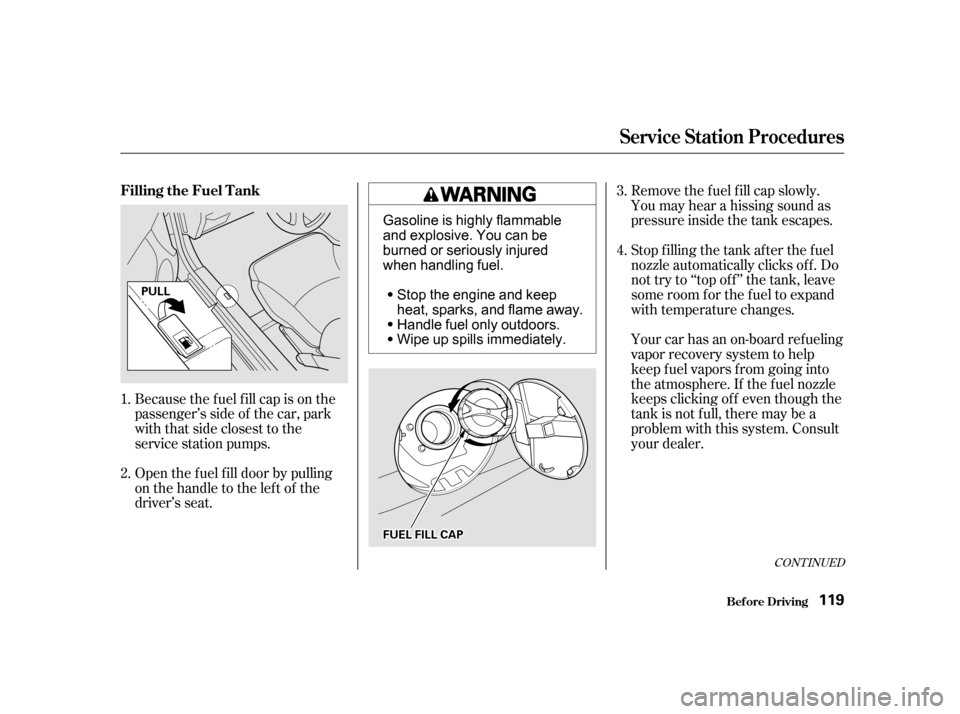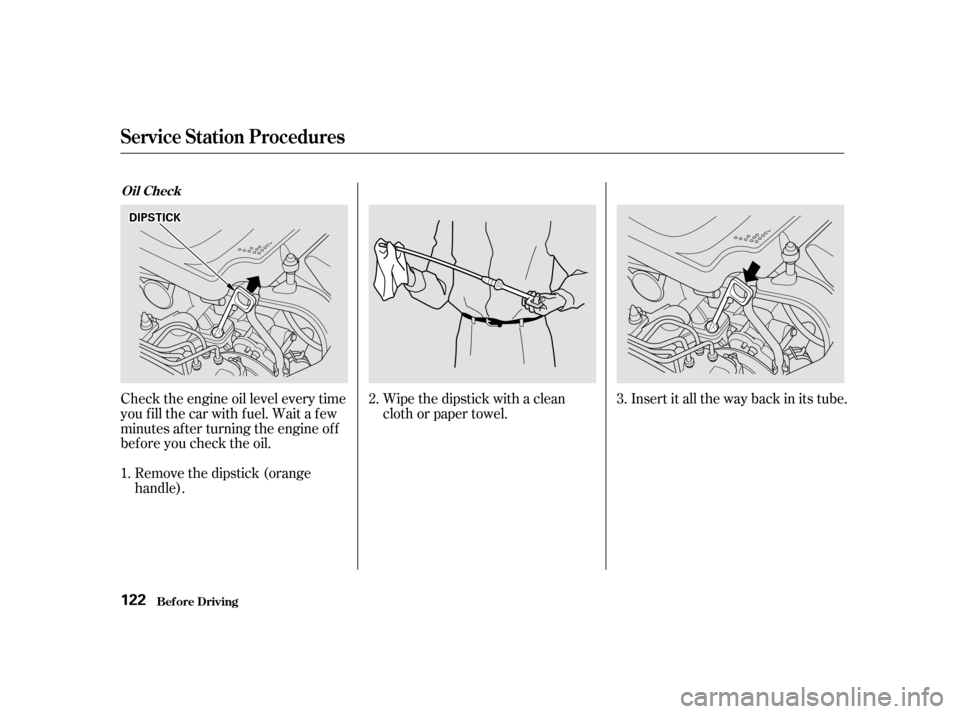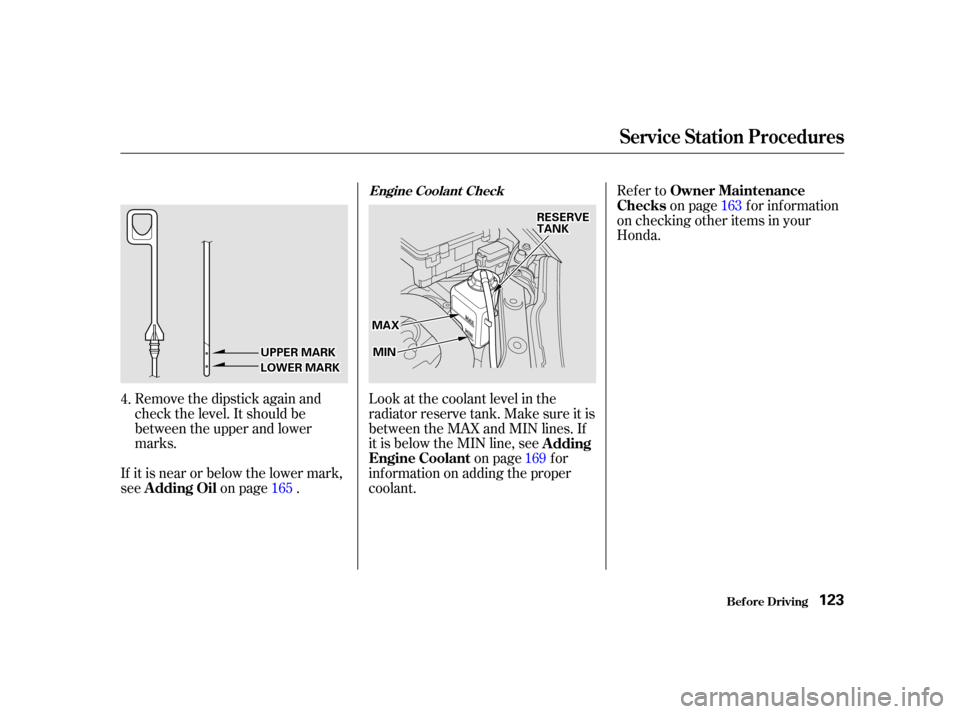engine HONDA INSIGHT 2002 1.G Owner's Manual
[x] Cancel search | Manufacturer: HONDA, Model Year: 2002, Model line: INSIGHT, Model: HONDA INSIGHT 2002 1.GPages: 270, PDF Size: 3.62 MB
Page 120 of 270

Bef ore you begin driving your Honda,
youshouldknowwhatgasolineto
use, and how to check the levels of
important f luids. You also need to
know how to properly store luggage
or packages. The inf ormation in this
section will help you. If you plan to
add any accessories to your car,
please read the inf ormation in this
section f irst..............................
Break-in Period .118
.........................................
Gasoline .118
.........
Service Station Procedures . 119
................
Filling the Fuel Tank . 119
....................
Opening the Hood .120
...............................
Oil Check .122
.........
Engine Coolant Check . 123
...............................
Fuel Economy .124
.....................
Vehicle Condition .124
...........................
Driving Habits .124
...
Accessories and Modif ications . 126
.............................
Carrying Cargo .128
.................................
Load Limit .129
Bef ore Driving
Bef ore Driving117
Page 121 of 270

During this period:Avoid full-throttle starts and rapid
acceleration. We recommend gasolines containing
detergent additives that help prevent
f uel system and engine deposits.
Avoidhardbraking.Newbrakes
need to be broken-in by moderate
use f or the f irst 200 miles (300
km). In Canada, some gasolines contain
an octane-enhancing additive called
MMT. If you use such gasolines,
your emission control system
perf ormance may deteriorate and
the Malfunction Indicator Lamp on
your instrument panel may turn on.
If this happens, contact your
authorized Honda dealer f or service.
Help assure your car’s f uture
reliability and perf ormance by paying
extra attention to how you drive
during the f irst 600 miles (1,000 km).
Using gasoline containing lead will
damage your car’s emissions
controls. This contributes to air
pollution. Your Honda is designed to operate
on unleaded gasoline with a pump
octane number of 87 or higher. Use
of a lower octane gasoline can cause
a persistent, heavy metallic rapping
noise in the engine that can lead to
mechanical damage.
Youshouldfollowthesesamere-
commendations with an overhauled
or exchanged engine, or when the
brakes are relined. Do not change the oil until the
recommended time or mileage
intervalshowninthemaintenance
schedule.
Break-in Period, Gasoline
Bef ore Driving
Break-in Period Gasoline
118
Page 122 of 270

Open the f uel f ill door by pulling
onthehandletotheleftof the
driver’s seat.Removethefuelfillcapslowly.
You may hear a hissing sound as
pressure inside the tank escapes.
Stop f illing the tank af ter the f uel
nozzle automatically clicks of f . Do
not try to ‘‘top off’’ the tank, leave
some room f or the f uel to expand
with temperature changes.
Your car has an on-board ref ueling
vapor recovery system to help
keep f uel vapors f rom going into
the atmosphere. If the fuel nozzle
keeps clicking of f even though the
tank is not f ull, there may be a
problem with this system. Consult
your dealer.
Because the f uel f ill cap is on the
passenger’s side of the car, park
with that side closest to the
service station pumps.
1.
2. 3.
4.
CONT INUED
Filling the Fuel Tank
Service Station Procedures
Bef ore Driving119
F FU
UE EL
L F
FIILLL L C
CAA P
P
P
P
U
UL LLL
Gasoline is highly flammable
and explosive. You can be
burned or seriously injured
when handling fuel.
Stop the engine and keep
heat, sparks, and flame away.
Handle fuel only outdoors.
Wipe up spills immediately.
Page 125 of 270

Wipe the dipstick with a clean
cloth or paper towel.Insert it all the way back in its tube.
Remove the dipstick (orange
handle).
Check the engine oil level every time
you f ill the car with f uel. Wait a f ew
minutes af ter turning the engine of f
bef ore you check the oil.
2.
3.
1.
Oil Check
Service Station Procedures
Bef ore Driving122
D D I
IPP S
ST TI
ICCK K
Page 126 of 270

Remove the dipstick again and
check the level. It should be
between the upper and lower
marks.Look at the coolant level in the
radiator reserve tank. Make sure it is
between the MAX and MIN lines. If
it is below the MIN line, see
on page f or
inf ormation on adding the proper
coolant.
If it is near or below the lower mark,
see
on page . Refer to
on page f or inf ormation
on checking other items in your
Honda.
4. 165 169163
A dding
Engine Coolant
A dding Oil Owner Maintenance
Checks
Engine Coolant Check
Service Station Procedures
Bef ore Driving123
M M A
AX
X R
RE
ES
SE ER
RV V E
E
T
T A
A N
NK K
M
M I
INN
U
UP PP
PE
ER
R M
M A
AR
RKK
L
LO OW WE ER
R M
M A
AR
RKK
Page 127 of 270

The condition of your car and your
driving habits are the two most
important things that affect the fuel
mileage you get.
Always maintain your car according
to the maintenance schedule. This
will keep it in top operating condition.
An important part of that mainte-
nance is the(see page ). For
example, an underinf lated tire
causes more ‘‘rolling resistance,’’
which uses f uel. It also wears out
f aster, so check the tire pressure at
least monthly. Engine oil also af f ects f uel economy.
The f uel ef f icient, low-viscosity
0W-20 oil recommended f or your
Insightisformulatedtohelpthe
engine use less f uel. This oil is
available at your Honda dealer.
In winter, the build-up of snow on
your car’s underside adds weight and
rolling resistance. Frequent cleaning
helps your f uel mileage and reduces
thechanceof corrosion.
You can improve f uel economy by
driving moderately. Rapid acceler-
ation, abrupt cornering, and hard
braking use more f uel.
To get the best f uel mileage, drive in
the highest gear that is practical for
the speed you are driving, and
always accelerate slowly.You may f ind that your Insight’s
unique combination of an engine and
an electric motor has driving
characteristics that are somewhat
dif f erent f rom what you are used to.
Shif t Up and Shif t Down indicators
(5-speed manual transmission only)
on the instrument panel show when
to shif t to a higher or lower gear. By
shifting as soon as the indicator
comes on, you will keep the engine
operating in its most economical
range.
Wind resistance causes vehicles to
usemorefuelathigherspeeds.
Driving at moderate speeds on the
highway reduces wind resistance
and conserves f uel. Depending on traf f ic conditions, try
to maintain a constant speed. Every
time you slow down and speed up,
your car uses extra f uel.
163
Fuel Economy
Bef ore Driving
Vehicle Condition
Owner Maintenance
Checks Driving Habits
124
Page 128 of 270

A cold engine uses more f uel than a
warm engine. It is not necessary to
‘‘warm-up’’ a cold engine by letting it
idle f or a long time. You can drive
away in about a minute, no matter
how cold it is outside. The engine
will warm up f aster, and you get
better f uel economy. To cut down on
the number of ‘‘cold starts,’’ try to
combine several short trips into one.
The air conditioning puts an extra
load on the engine which makes it
usemorefuel.Turnoff theA/Cto
cutdownonairconditioninguse.
Use the f low-through ventilation
when the outside air temperature is
moderate.If air conditioning is needed, you can
save some f uel by using the A/C in
‘‘Econ’’ mode. When the outside
temperature is above 41°F (5°C),
this mode allows the Auto Idle Stop
f unction to shut of f the engine when
the vehicle is stopped, resulting in
fuel savings.
You may notice that using the A/C
causes a greater drop in f uel
economy than you are used to in
other vehicles. Although the amount
of extra f uel used by the A/C load on
the engine is no greater than other
vehicles, it is more noticeable
because of your Insight’s excellent
f uel mileage. Using the A/C in hot
weather may result in f uel economy
that is lower than expected.
Fuel Economy
Bef ore Driving125
Page 134 of 270

This section gives you tips on
starting the engine under various
conditions, and how to operate the
manual transmission. It also includes
important inf ormation on parking
your car, and the braking system.........................
Preparing to Drive .132
.......................
Starting the Engine .133
Starting in Cold Weather ....................
at High Altitude .133
....
5-speed Manual Transmission . 134
............................
Auto Idle Stop .135
Shif t Up/Shif t Down ...............................
Indicators .137
..............
Engine Speed Limiter . 137
..............
Automatic Transmission . 138
Continuously Variable ............
Transmission (CVT) . 138
.
Shif t Lever Position Indicator . 138
................
Shif t Lever Positions . 138
.............
Engine Speed Limitter . 141
....................
Shif t Lock Release . 142
............................
Auto Idle Stop .143
...........................................
Parking .145
..............................
Parking Tips .145
.....................
The Braking System .146
.............
Brake Wear Indicators . 146
...............
Brake System Design . 147
.......................
Anti-lock Brakes .147
...............
Driving in Bad Weather . 149
...........................
Towing a Trailer .150
Driving
Driving131
Page 135 of 270

Make sure all windows, mirrors,
and outside lights are clean and
unobstructed. Remove f rost, snow,
or ice.Check the adjustment of the seat
(see page ).
Check the adjustment of the
inside and outside mirrors (see
page ).
Turn the ignition switch ON (II).
Check the indicator lights in the
instrument panel.
Start the engine (see page ).
Check the gauges and indicator
lights in the instrument panel (see
page ).
Check that any items you may be
carrying with you inside are stored
properly or f astened down
securely. Visually check the tires. If a tire
looks low, use a gauge to check its
pressure. Check that the hood and hatch are
f ully closed.
Youshoulddothefollowingchecks
and adjustments every day bef ore
you drive your car.
Make sure the doors are securely
closed and locked.
Fasten your seat belt. Check that
your passenger has f astened his or
her seat belt (see page ).
1.
2.
3.
4. 5.
6.
7.
8.
9.
10. 11. 45
76
78
15 133
Preparing to Drive
Driving132
Page 136 of 270

Apply the parking brake.
In cold weather, turn of f all
electrical accessories to reduce
the drain on the battery.
Push the clutch pedal down all the
way. START (III) does not
f unction unless the clutch pedal is
depressed.
Without touching the accelerator
pedal, turn the ignition key to the
START (III) position. If the engine
does not start right away, do not
hold the key in START (III) f or
more than 15 seconds at a time.
Pause f or at least 10 seconds
bef ore trying again.
If the engine does not start within
15 seconds, or starts but stallsright away, repeat step 4 with the
accelerator pedal pressed half-way
down. If the engine starts, release
pressure on the accelerator pedal
so the engine does not race.
If the engine still does not start,
press the accelerator pedal all the
way down and hold it there while
starting in order to clear f looding.
As bef ore, keep the ignition key in
the START (III) position f or no
more than 15 seconds. Return to
step 5 if the engine does not start.
If it starts, lif t your f oot of f the
accelerator pedal so the engine
does not race.
An engine is harder to start in cold
weather. The thinner air f ound at
high altitude above 8,000 f eet (2,400
meters) adds to the problem.
Use the f ollowing procedure: Turn of f all electrical accessories
to reduce the drain on the battery.
Push the accelerator pedal half-
way to the f loor and hold it there
while starting the engine. Do not
hold the ignition key in START
(III) f or more than 15 seconds.
When the engine starts, release
the accelerator pedal gradually as
the engine speeds up and smooths
out.
If the engine fails to start in step 2,
push the accelerator pedal to the
f loor and hold it there while you
try to start the engine for no more
than 15 seconds. If the engine
does not start, return to step 2.
Make sure the shif t lever is in
Park. Press on the brake pedal.
1.
2.
3.
4.
5. 6.
1.
2.
3.
Manual Transmission:
Automatic Transmission:
Starting the Engine
Driving
Starting in Cold Weather at High
A ltitude (A bove 8,000 f eet/
2,400 meters)
133